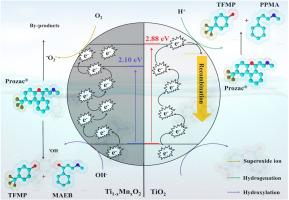Journal of Environmental Chemical Engineering ( IF 7.4 ) Pub Date : 2020-09-28 , DOI: 10.1016/j.jece.2020.104543 Ailton J. Moreira , João O.D. Malafatti , Tania R. Giraldi , Elaine C. Paris , Ernesto C. Pereira , Vagner Romito de Mendonça , Valmor Roberto Mastelaro , Gian P.G. Freschi

|
TiO2 nanoparticles were efficiently doped with Mn applying microwave-assisted synthesis method. Anatase phase was confirmed by XRD pattern, which did not exhibit the peaks associated with MnOx contamination. Raman spectroscopy showed a displacement of up to 5 cm−1 in the O-Ti-O vibrational mode, suggesting that Ti was replaced by Mn. Oxidation state (Mn3+) was confirmed via high-resolution XPS spectrum of Mn 2p energy level. Incorporation of Mn into the TiO2 network resulted in increased surface area (64.6 m2 g−1), average particle size up to 16 nm, and bandgap reduction of up to 43 %. The photocatalytic properties of the materials were investigated through Prozac® degradation and improvement of up to 14 % (Ti-0.73 Mn) and 26 % (Ti-0.38 Mn) was seen on comparing doped TiO2 versus pure TiO2 during photocatalysis. Furthermore, after Prozac® photodegradation, TFMP was identified as the main by-product while MAEB and PPMA (other by-products) were seen to compete with each other in the degradation mechanism. In addition to the quantitative analysis done for Prozac®, TFMP, MAEB, and PPMA, LC MS-Q-TOF analysis was performed, confirming that in the presence of Mn-doped TiO2, specific by-products were formed, probably due to more oxidizing species being present in this reaction system. The present study has shown unprecedented evidence that the application of TiO2 nanoparticles efficiently doped with Mn promotes Prozac® degradation by specific mechanisms.
中文翻译:

Mn掺杂的TiO 2纳米粒子介导的Prozac®光降解:副产物和机理评估建议
微波辅助合成法将TiO 2纳米颗粒有效地掺入了Mn。通过XRD图证实了锐钛矿相,该图没有显示出与MnOx污染相关的峰。拉曼光谱在O-Ti-O振动模式下显示最大5 cm -1的位移,表明Ti被Mn取代。通过Mn 2p能级的高分辨率XPS光谱确定了氧化态(Mn 3+)。Mn加入TiO 2网络导致表面积增加(64.6 m 2 g -1),平均粒径最高达16 nm,带隙减少最高达43%。通过降解降解来研究材料的光催化性能,在光催化过程中比较掺杂的TiO 2与纯TiO 2时,可以看到高达14%(Ti-0.73 Mn)和26%(Ti-0.38 Mn)的改善。此外,经过Prozac®光降解后,TFMP被确定为主要副产物,而MAEB和PPMA(其他副产物)在降解机理上相互竞争。除了对Prozac®,TFMP,MAEB和PPMA进行定量分析外,还进行了LC MS-Q-TOF分析,证实存在Mn掺杂的TiO 2,形成了特定的副产物,可能是由于该反应系统中存在更多的氧化物质。本研究显示了空前的证据,表明有效掺杂锰的TiO 2纳米颗粒的应用通过特定机制促进了Prozac®降解。











































 京公网安备 11010802027423号
京公网安备 11010802027423号